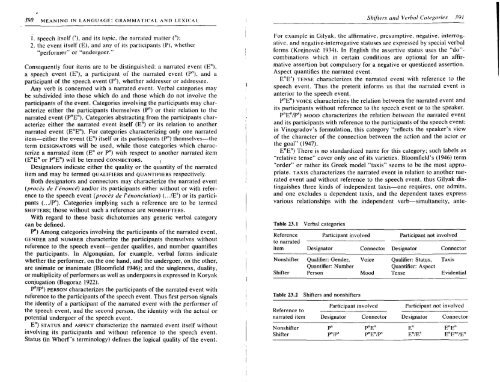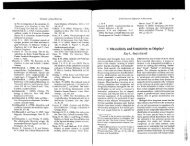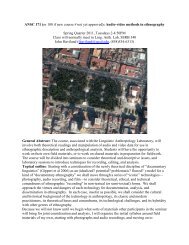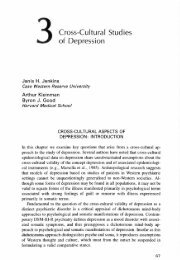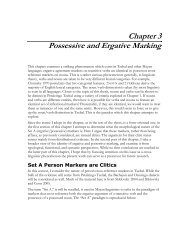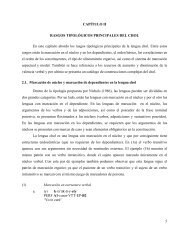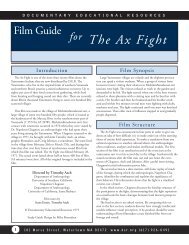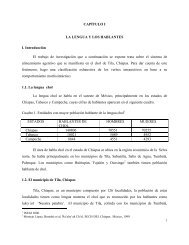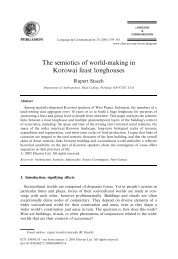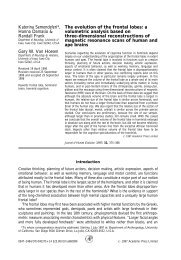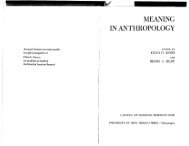Shifters and Verbal Categories
Shifters and Verbal Categories
Shifters and Verbal Categories
Create successful ePaper yourself
Turn your PDF publications into a flip-book with our unique Google optimized e-Paper software.
390 MEANING IN LANGUAGE: GRAMMATICAL AND LEXICAL.<br />
1. speech itself (0, <strong>and</strong> its topic, the narrated matter (");<br />
2. the event itself (E). <strong>and</strong> any of its participants (P), whether<br />
"performer" or "undergoer."<br />
Consequently four items are to be distinguished: a narrated event (En),<br />
a speech event (Es), a participant of the narrated event (Pn), <strong>and</strong> a<br />
participant of the speech event (P'), whether addresser or addressee.<br />
Any verb is concerned with a narrated event. <strong>Verbal</strong> categories may<br />
be subdivided into those which do <strong>and</strong> those which do not involve the<br />
participants of the event. <strong>Categories</strong> involving the participants may characterize<br />
either the participants themselves (Pn) or their relation to the<br />
narrated event (PnEn). <strong>Categories</strong> abstracting from the participants characterize<br />
either the narrated event itself (En) or its relation to another<br />
narrated event (EnEn). For categories characterizing only one narrated<br />
item-either the event (En) itself or its participants (Pn) themselves-the<br />
term DESIGNATORS will be used, while those categories which characterize<br />
a narrated item (En or Pn) with respect to another narrated item<br />
(EnEn or PnEn) will be termed CONNECTORS. I<br />
Designators indicate either the quality or the quantity of the narrated<br />
item <strong>and</strong> may be termed QUALIFIERS <strong>and</strong> QUANTIFIERS respectively.<br />
Both designators <strong>and</strong> connectors may characterize the narrated event<br />
(procPs de I'e'nonce') <strong>and</strong>/or its participants either without or with reference<br />
to the speech event (proces de l'e'nonciation) (.../Es) or its participants<br />
(...IPS). <strong>Categories</strong> implying such a reference are to be termed<br />
SHIFTERS; those without such a reference are NONSHIFTERS.<br />
With regard to these basic dichotomies any generic verbal category<br />
can be defined.<br />
Pn) Among categories involving the participants of the narrated event,<br />
GENDER <strong>and</strong> NUMBER characterize the participants themselves without<br />
reference to the speech event-gender qualifies, <strong>and</strong> number quantifies<br />
the participants. In Algonquian, for example, verbal forms indicate<br />
whether the performer, on the one h<strong>and</strong>, <strong>and</strong> the undergoer, on the other,<br />
are animate or inanimate (Bloomfield 1946); <strong>and</strong> the singleness, duality,<br />
or multiplicity of performers as well as undergoers is expressed in Koryak<br />
conjugation (Bogoraz 1922).<br />
Pn/P" PERSON characterizes the participants of the narrated event with<br />
reference to the participants of the speech event. Thus first person signals<br />
the identity of a participant of the narrated event with the performer of<br />
the speech event, <strong>and</strong> the second person, the identity with the actual or<br />
potential undergoer of the speech event.<br />
En) STATUS <strong>and</strong> ASPECT characterize the narrated event itself without<br />
involving its participants <strong>and</strong> without reference to the speech event.<br />
Status (in Whorf's terminology) defines the logical quality of the event.<br />
<strong>Shifters</strong> crrrd <strong>Verbal</strong> <strong>Categories</strong> 391<br />
For example in Gilyak, the affirmative, presumptive. negative. interrog-<br />
ative, <strong>and</strong> negative-interrogative statuses are expressed by special verbal<br />
forms (Krejnovii: 1934). In English the assertive status uses the "do"-<br />
combinations which in certain conditions are optional for an affir-<br />
mative assertion but compulsory for a negative or questioned assertion.<br />
Aspect quantifies the narrated event.<br />
EnE" TENSE characterizes the narrated event with reference to the<br />
speech event. Thus the preterit informs us that the narrated event is<br />
anterior to the speech event.<br />
YEn) VOICE characterizes the relation between the narrated event <strong>and</strong><br />
its participants without reference to the speech event or to the speaker.<br />
PnEn/P" MOOD characterizes the relation between the narrated event<br />
<strong>and</strong> its participants with reference to the participants of the speech event:<br />
in Vinogradov's formulation, this category "reflects the speaker's view<br />
of the character of the connection between the action <strong>and</strong> the actor or<br />
the goal" (1947).<br />
EnEn) There is no st<strong>and</strong>ardized name for this category; such labels as<br />
"relative tense" cover only one of its varieties. Bloomfield's (1946) term<br />
"order" or rather its Greek model "taxis" seems to be the most appro-<br />
priate. TAXIS characterizes the narrated event in relation to another nar-<br />
rated event <strong>and</strong> without reference to the speech event, thus Gilyak dis-<br />
tinguishes three kinds of independent taxis-one requires, one admits,<br />
<strong>and</strong> one excludes a dependent taxis, <strong>and</strong> the dependent taxes express<br />
various relationships with the independent verb-simultaneity, ante-<br />
Table 23.1 <strong>Verbal</strong> categories<br />
Reference Participant involved<br />
to narrated<br />
item Designator Connector<br />
Nonshifter Qualifier: Gender, Voice<br />
Quantifier: Number<br />
Shifter Person Mood<br />
Table 23.2 <strong>Shifters</strong> <strong>and</strong> nonshifters<br />
--<br />
Participant not involved<br />
Designator Connector<br />
Qualifier: Status, Taxis<br />
Quantifier: Aspect<br />
Tense Evidential<br />
Reference to<br />
Participant involved Participant not involved<br />
narrated item Designator Connector Designator Connector<br />
Nonshifter Pn PnEn En EnEn<br />
Shifter PnIPs PnEn/Ps EnIEs EnEns/Es


